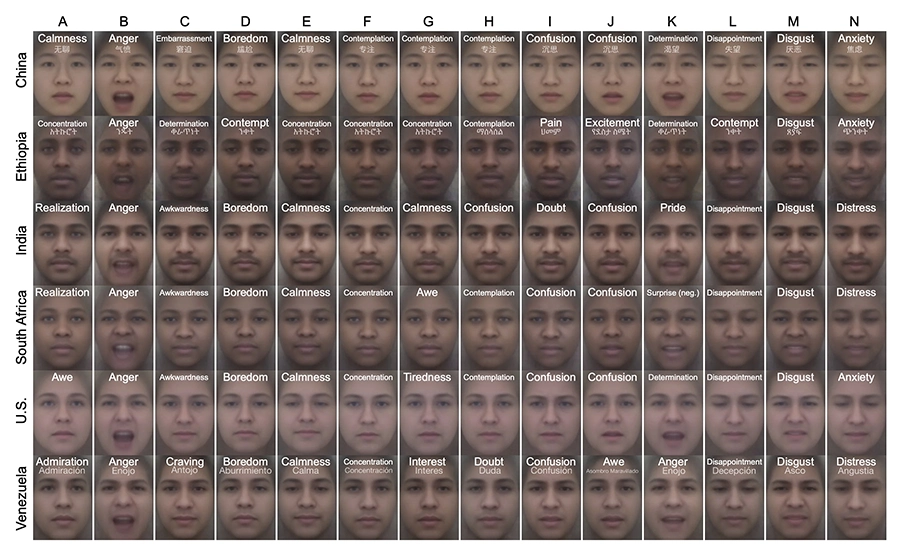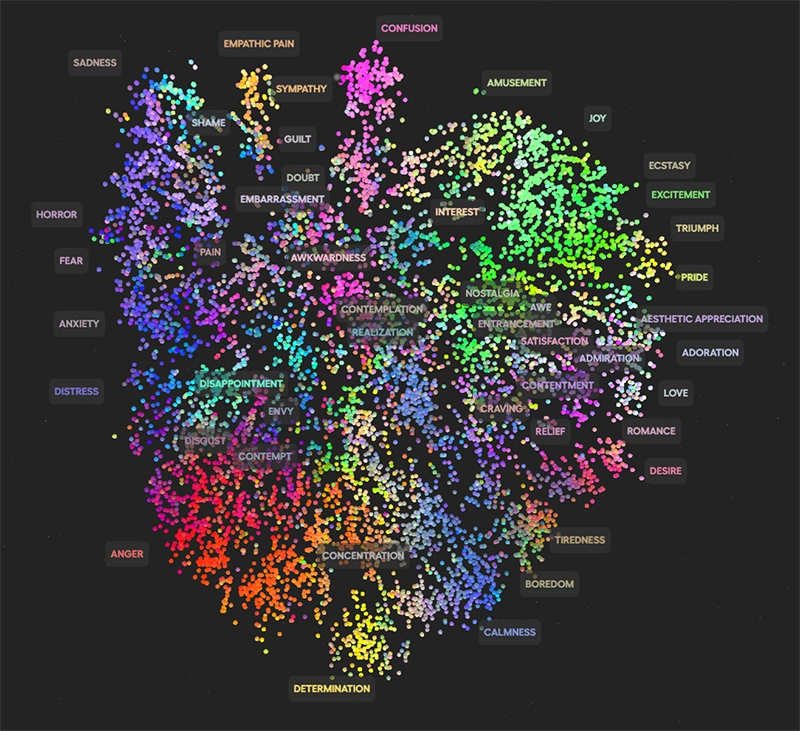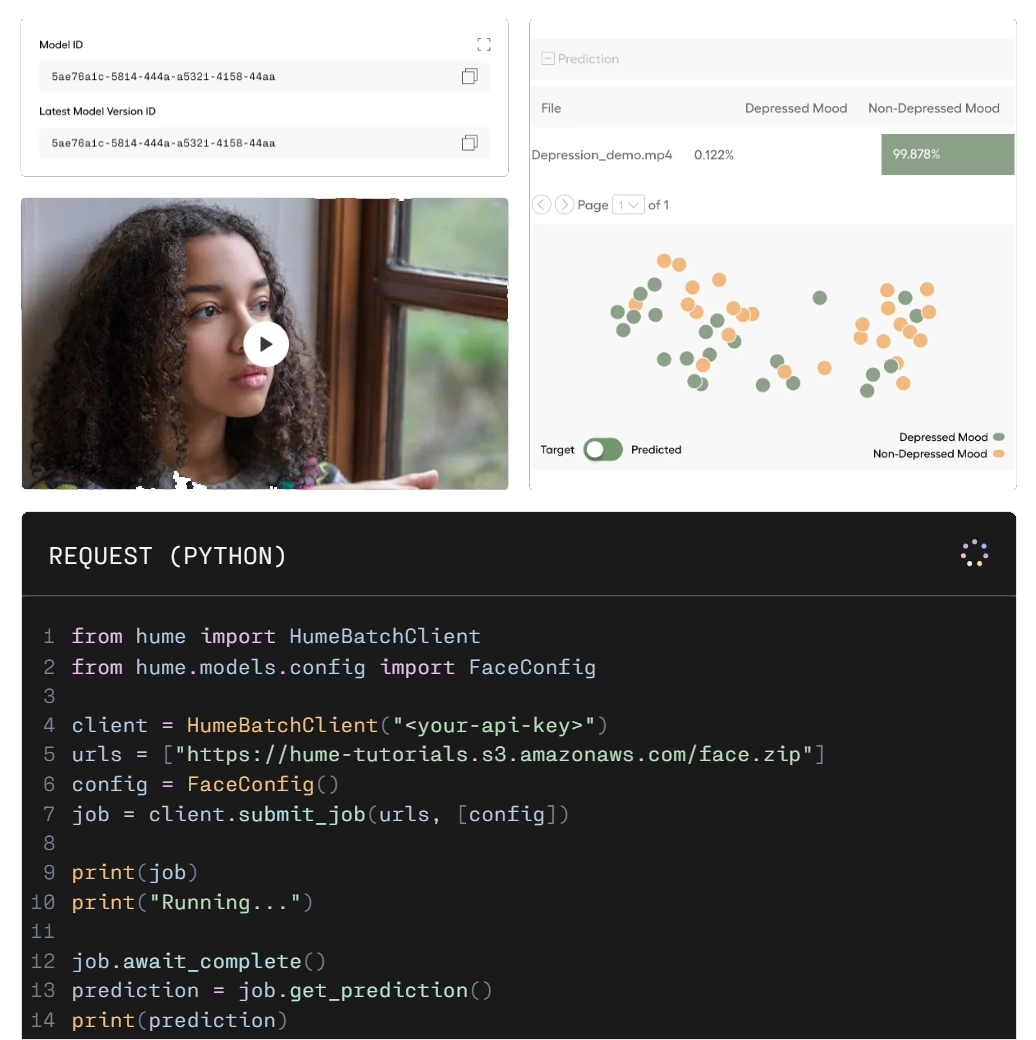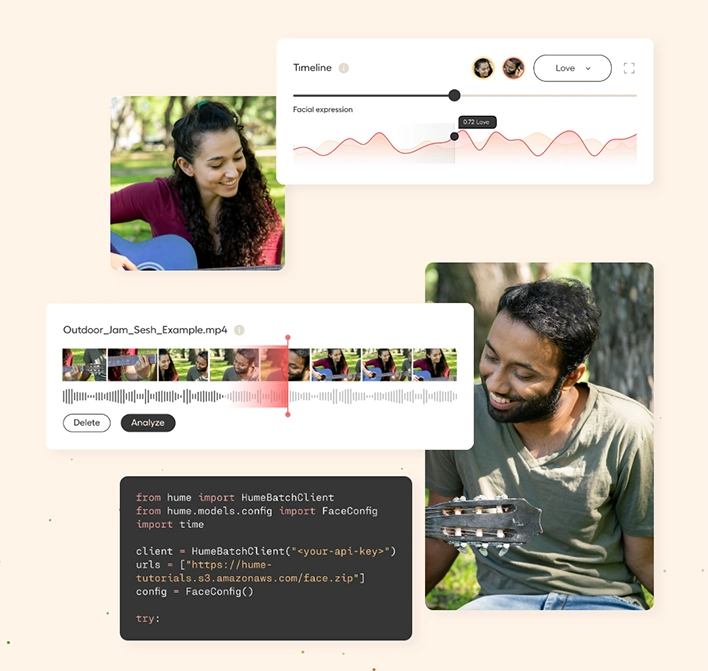Introduction to Hume AI: Revolutionizing Voice with Emotion
In the rapidly evolving world of artificial intelligence, a new frontier has been crossed with the introduction of Hume AI. This cutting-edge AI voice revolution leverages Emotional Voice Technology to transform the way we interact with machines, making it not just a leap in technology but a giant stride towards genuinely empathetic digital communication. Unlike its predecessors, such as PlayHT, Vocol, or others that focused on text-to-speech capabilities without the nuance of emotional engagement, Hume AI stands out by incorporating an emotional and empathetic voice into its core functionality.
Hume AI is designed to measure expressions along with language, enabling it to build a voice interface that is not just interactive but also empathic. By interpreting emotional expressions and generating empathic responses, Hume AI becomes the first AI tool to have an emotional intelligence akin to humans. This innovation is powered by its empathic voice interface (EVI), a conversational voice API that measures nuanced vocal modulations, guiding language and speech generation towards better emotional quotient (EQ), prosody, and interruptibility, all aligned with the user’s emotional state.
The Hume AI tool extends its application across various sectors, from AI research, social networks, and health & wellness to call center analytics, brand analysis, and even creative tools, demonstrating its versatility and the vast potential of emotional voice technology in enhancing human-AI interaction. Its foundation is built on more than a decade of research, millions of proprietary data points, and a substantial number of publications in leading journals, ensuring that its insights into human expressions are both profound and scientifically validated.
🔥 Pro Tip: When integrating Hume AI into your application, consider the unique ways it can enhance user experience by making interactions more natural and emotionally resonant. Whether it’s customer service, educational tools, or entertainment, Hume AI’s ability to understand and mirror human emotions can significantly elevate the quality of engagement.
👇 Have you considered how emotional voice technology could revolutionize your industry or field? Whether it’s through improved customer interactions, enhanced learning experiences, or more empathic health care services, the implications are enormous. Share your thoughts and ideas below!
🚀 Take Action: Ready to bring a new dimension of emotional intelligence to your technology? Explore Hume AI and start experimenting with its empathic voice interface to discover the vast possibilities of emotionally aware AI in your projects.
Understanding Emotional Intelligence in AI
Artificial Intelligence (AI) has taken a monumental leap forward with the integration of Emotional Intelligence, marking a pivotal evolution in how AI understands and interacts with humans on an emotional level. This advancement is not just about enhancing AI with new features; it’s about redefining the essence of human-AI interaction. Hume AI stands at the forefront of this revolution, embedding AI emotional understanding into its core, enabling machines to interpret and respond to human emotions in a way that was previously unimaginable.

The Science Behind Hume AI’s Emotional Intelligence
At the heart of Hume AI’s Emotional Intelligence lies a deep, scientific understanding of human expression and emotion. The development of Hume AI’s science is rooted in extensive emotional AI research, spanning over a decade, involving millions of proprietary data points, and resulting in significant contributions to leading journals. This research has not only advanced our understanding of AI emotional processing but has also set new standards for how AI can empathize with and respond to human emotions.
Hume AI leverages sophisticated models to measure a wide array of emotional expressions, from facial movements to speech prosody and vocal bursts, capturing the subtle nuances that convey meaning beyond words. This ability to understand and interpret human emotions stems from Hume AI’s science, which incorporates cutting-edge machine learning techniques and datasets that are rich in emotional depth and variety.
By integrating these advanced Emotional AI capabilities, Hume AI achieves a level of emotional intelligence that enables it to interact with users in a more natural, understanding, and engaging manner. Whether it’s detecting the tone of a customer service call, assessing patient well-being in healthcare, or enhancing the emotional impact of digital content, Hume AI’s applications are as diverse as they are transformative.
🔥 Pro Tip: Leveraging Hume AI in your applications goes beyond just interpreting emotions; it’s about creating experiences that are truly aligned with human well-being. Consider how the emotional intelligence of Hume AI can be used to improve engagement, satisfaction, and outcomes in your specific domain.
👇 How do you see Emotional AI capabilities impacting the future of technology and human interaction? Whether it’s in education, healthcare, customer service, or entertainment, the potential for creating more empathetic and understanding AI systems is vast. Share your insights and envision how emotional AI research could shape the future.
🚀 Take Action: Embark on a journey to explore the depths of emotional intelligence with Hume AI. By integrating Hume AI’s science into your projects, you can unlock new dimensions of AI interaction that resonate on a human level. Discover the potential of AI emotional processing and redefine what’s possible in AI-driven solutions.
The Power of Emotional Voices in AI
In today’s digital age, the integration of emotional Voice AI into our daily interactions signifies a groundbreaking shift towards more humane and emotionally resonant AI systems. Hume AI is at the vanguard of this shift, harnessing AI emotional expression to create voices that understand and convey emotions as naturally as a human would. This leap in Voice Emotional Intelligence is not just a technological advancement; it’s a step closer to bridging the emotional gap between humans and machines.
How Hume AI Creates Empathetic and Emotional Voices
Hume AI differentiates itself by focusing on creating emotional voices with a depth of empathetic technology unprecedented in the realm of AI. Utilizing extensive voice AI development techniques, Hume AI analyses a wide spectrum of human emotions through vocal cues, speech prosody, and language use to generate responses that are emotionally aligned with the user’s state of mind.
This emotional attunement is achieved through sophisticated models trained on vast datasets of human interaction, capturing the essence of AI emotional expression. By doing so, Hume AI not only understands the literal meaning behind words but also grasps the emotional undertones, enabling it to respond in ways that feel genuinely understanding and empathetic. This is a significant leap in voice AI development, moving beyond mere speech synthesis to crafting voices that truly resonate with users on an emotional level.
Comparison: Hume AI vs. Traditional AI Voices
The contrast between Hume AI and traditional AI voices lies primarily in their approach to emotional intelligence and user interaction. Traditional AI voices, while proficient in converting text to speech, often fall short in AI emotional expression, resulting in interactions that can feel mechanical and devoid of empathy. Hume AI, on the other hand, is designed with Voice Emotional Intelligence at its core, enabling it to detect, interpret, and express emotions in a way that mirrors human empathy.
Hume AI vs. traditional AI voices is a comparison that highlights the evolution of AI voice technology advancements. While traditional systems focus on the functional aspect of voice synthesis, Hume AI pioneers a holistic approach that considers emotional engagement as equally important. This shift towards creating emotional voices signifies Hume AI’s empathetic technology as a fundamental pillar of its innovation, setting a new standard for voice AI comparison.
🔥 Pro Tip: To fully leverage the potential of Hume AI, consider the emotional context of your application. Whether it’s providing support in a customer service setting or offering companionship through a digital assistant, the use of emotional Voice AI can significantly enhance the quality and impact of user interactions.
👇 Reflect on your experiences with AI voices. How do you think AI emotional expression can change the future of digital interactions? Whether it’s making technology more accessible or creating deeper connections between users and digital services, the possibilities are endless. Share your thoughts on the potential transformations brought about by voice AI advancements.
🚀 Take Action: Dive into the world of Hume AI and explore how its empathetic technology can revolutionize your projects. By embracing AI voice technology advancements, you can not only enhance user engagement but also pave the way for more emotionally intelligent and understanding AI systems.
Empathic Voice Interface (EVI): The Heart of Hume AI
In the rapidly evolving landscape of artificial intelligence, Hume AI emerges as a beacon of innovation with its Empathic Voice Interface (EVI), a technology that fundamentally transforms how AI understands and interacts with humans on an emotional level. EVI technology is more than just a breakthrough; it’s a testament to Hume AI’s voice innovation, embodying the essence of AI empathy in conversation and setting a new benchmark for emotionally intelligent interactions.
Building Empathy into Every Conversation
At the core of EVI’s groundbreaking approach is its ability to infuse empathic AI communication into every interaction, ensuring that conversations with AI are not just transactions but genuine exchanges. This leap in conversational empathy is powered by sophisticated EVI technology, which analyzes vocal nuances, language use, and emotional cues to provide responses that are not only relevant but also emotionally resonant.
Hume AI leverages advanced machine learning algorithms and vast datasets of human interactions to create an interface that can truly understand and mirror human emotions. This focus on empathic AI mechanisms allows EVI to discern the underlying emotional states of users, enabling it to adapt its responses accordingly. Whether it’s providing comfort, excitement, or understanding, EVI makes every interaction feel personal and meaningful.
Technical Insights: How EVI Works
EVI workings are a marvel of Hume AI technology, integrating several layers of emotional intelligence to achieve a truly empathetic communication experience. It begins with real-time analysis of the user’s voice, picking up on subtle modulations that convey emotions. This analysis is bolstered by EVI’s deep understanding of speech prosody, which examines the rhythm, tone, and pitch of speech to infer emotional states.
Following the analysis, EVI employs its empathic AI mechanisms to generate responses that are emotionally aligned with the user’s sentiments. This involves a dynamic selection of language and vocal tones that reflect understanding and empathy. Moreover, EVI’s conversational model is continuously learning, absorbing insights from each interaction to enhance its emotional acuity over time.
🔥 Pro Tip: To fully harness the potential of EVI technology, consider the emotional landscape of your application’s use case. Tailoring EVI’s settings to align with the specific emotional needs and contexts of your users can significantly enhance the efficacy and impact of its empathetic responses.
👇 How do you envision empathic Voice Interface revolutionizing your interactions with AI? Whether it’s in customer service, healthcare, education, or any other field, the introduction of AI empathy in conversation opens up new avenues for engagement and support. Share your expectations or experiences with empathic AI communication.
🚀 Take Action: Explore the possibilities of EVI technology within Hume AI to bring a new dimension of empathy to your projects. By integrating Hume AI’s voice innovation into your applications, you’re not just improving interactions; you’re transforming them into experiences that truly connect and resonate with users on an emotional level.
Implementing Hume AI Across Industries
The advent of Hume AI marks a pivotal moment in the industry AI transformation, showcasing the vast potential of emotional AI uses across various sectors. From enhancing customer service experiences to revolutionizing mental health support, Hume AI applications are setting new standards for empathy and understanding in digital interactions.
Revolutionizing Customer Service with Emotional Intelligence
In the realm of customer service, Hume AI introduces a paradigm shift, integrating emotional intelligence into customer interactions to create more meaningful and satisfying exchanges. AI in customer service is no longer about automating responses but about understanding the emotional context of each customer query and responding in a way that feels personally tailored and genuinely empathetic.
By leveraging Hume AI for AI customer support, businesses can detect subtle cues in customer communication, such as tone, sentiment, and urgency, allowing them to respond with an appropriate level of empathy and care. This not only improves customer satisfaction but also builds stronger relationships between brands and their customers, fostering loyalty and trust through emotional AI uses.
Enhancing Mental Health Applications with Hume AI
Hume AI also stands out in its capacity to enhance mental health applications by offering AI mental health support with a level of emotional intelligence previously unseen. emotional AI in healthcare opens up new avenues for providing support and therapy, enabling applications to recognize and respond to users’ emotional states in real-time.
Through Hume AI’s therapeutic applications, mental health platforms can offer personalized support, identifying signs of distress, anxiety, or depression through vocal and textual cues. This allows for timely intervention and support, making mental health care more accessible and effective. The application of Hume AI in this field underscores the transformative potential of emotional AI uses in improving patient outcomes and providing compassionate care.
🔥Pro Tip: When integrating Hume AI across industries, consider the unique emotional dynamics and needs of your target audience. Tailoring Hume AI applications to fit these requirements can significantly amplify the impact of AI’s emotional intelligence, resulting in more engaging, supportive, and effective interactions.
👇 Reflect on the potential impacts of Hume AI in your industry. How could emotional AI uses transform the way businesses interact with customers or support mental health? Share your thoughts on how emotional intelligence can drive innovation and improve experiences across different sectors.
🚀 Take Action: Begin exploring the possibilities of Hume AI within your industry to unlock new levels of engagement and support. Whether it’s through AI in customer service or AI mental health support, Hume AI’s applications offer a pathway to more empathetic, understanding, and effective solutions. Discover how Hume AI can revolutionize your approach and set a new standard for excellence in your field.
Measuring Emotional Expressions with Unmatched Precision
In the ever-evolving landscape of artificial intelligence, Hume AI sets a new benchmark for emotional expression measurement, delivering insights with AI emotional accuracy that was once thought to be beyond the realm of technology. Through advanced Hume AI expression analytics, we’re now able to understand and interpret human emotions with a level of detail and precision unparalleled in the history of AI development.

The Role of Speech Prosody and Vocal Expression
Central to Hume AI’s innovation is its focus on speech prosody AI, a critical aspect of vocal expression measurement that allows for a nuanced understanding of emotions conveyed through voice. AI voice analytics go beyond mere words, analyzing variations in pitch, tone, and rhythm to detect underlying emotional states. This sophisticated approach to speech prosody AI enables Hume AI to capture the subtleties of human emotion, providing a richer, more complex picture of the speaker’s feelings and intentions.
Equally important is Hume AI’s capability in vocal expression measurement. By identifying distinct vocal expressions, such as laughter, sighs, and tones of urgency or calm, Hume AI offers an in-depth analysis of vocal cues that traditional text-based analytics could easily overlook. This advancement in AI voice analytics opens new doors for applications requiring empathetic human-machine interactions, ranging from customer service to mental health support.
Advanced Facial Expression and Dynamic Reaction Analysis
Hume AI further extends its emotional intelligence through facial expression AI, leveraging cutting-edge technology to analyze micro-expressions, eye movements, and other facial cues that convey a wide range of emotions. This level of Hume AI facial analytics is instrumental in interpreting non-verbal communication, providing a comprehensive understanding of the user’s emotional state without a single word being spoken.

Moreover, dynamic reaction AI represents another leap forward, enabling Hume AI to measure emotional reactions over time. This continuous analysis allows for the detection of shifts in emotion, offering insights into how people’s feelings evolve in response to different stimuli. Such dynamic reaction AI capabilities are invaluable in fields such as UX research, therapy, and entertainment, where understanding the ebb and flow of emotions is crucial to success.
🔥 Pro Tip: Leverage Hume AI’s expression analytics to enhance user engagement and satisfaction. Whether it’s by tailoring content to match the user’s emotional state or offering timely support when distress is detected, the potential applications of Hume AI’s emotional expression measurement are vast and varied.
👇 Consider how AI emotional accuracy can transform your industry. From more empathetic customer service bots to mental health apps that adjust to your mood, the possibilities are endless. Share how you envision using Hume AI’s advanced expression analytics in your work or daily life.
🚀 Take Action: Start integrating Hume AI’s comprehensive analytics into your projects to unlock deeper emotional insights and create truly empathetic AI solutions. Whether through speech prosody AI, vocal expression measurement, or facial expression analytics, Hume AI equips you with the tools to understand and respond to human emotions like never before.
Predicting Preferences with Hume AI
In the rapidly evolving world of artificial intelligence, Hume AI stands out with its groundbreaking approach to AI preference prediction. By harnessing the power of emotional intelligence prediction, Hume AI is transforming how systems understand and cater to individual user needs. This leap in Hume AI analytics marks a significant step towards a future where Personalized AI experiences are not just a luxury but a fundamental aspect of technology that users expect.
The Future of personalized AI Experiences
The advent of Hume AI in the landscape of AI user preferences heralds a new era in the future of emotional AI. This innovative technology goes beyond traditional data analysis, incorporating emotional intelligence to understand the nuanced preferences of users. By doing so, Hume AI analytics pave the way for truly personalized AI experiences, where recommendations, responses, and services are tailored to the individual’s emotional context and needs.
AI preference prediction powered by Hume AI offers a more dynamic and intuitive understanding of what users want, sometimes even before they explicitly express it. This capability is rooted in emotional intelligence prediction, which allows AI systems to interpret subtle cues and patterns in user behavior and emotional responses. The result is a more engaging and satisfying interaction, where users feel understood and valued on a personal level.
The future of emotional AI, as exemplified by Hume AI, promises a shift towards more empathetic and intuitive technology. In applications ranging from e-commerce and content streaming to healthcare and education, the ability to anticipate user preferences based on emotional intelligence will redefine the standards of user experience. This evolution towards personalized AI not only enhances user satisfaction but also fosters a deeper connection between humans and technology.
🔥 Pro Tip: To leverage the full potential of Hume AI in predicting user preferences, it’s crucial to integrate emotional data thoughtfully and ethically. Consider how emotional insights can enhance your service or product, and always prioritize user privacy and consent when collecting and analyzing emotional data.
👇 Imagine a world where every interaction with technology is perfectly aligned with your preferences and emotional state. How do you see emotional intelligence prediction shaping the future of user experiences in your field? Share your thoughts on the impact of personalized AI and how Hume AI analytics could transform the landscape of your industry.
🚀 Take Action: Begin exploring the capabilities of Hume AI to bring a new dimension of personalization to your projects. By incorporating AI preference prediction into your applications, you can create more engaging, responsive, and emotionally intelligent experiences for your users. Discover how Hume AI can help you lead the way in the future of emotional AI.
Deploying and Training Hume AI: A Step-by-Step Guide
In the dynamic world of artificial intelligence, Hume AI stands as a beacon of innovation, offering unprecedented capabilities in understanding and interacting with human emotions. For businesses and developers looking to harness these capabilities, Hume AI deployment and training become crucial steps. This AI training guide is designed to navigate you through implementing Hume AI effectively, ensuring you can leverage its full potential to develop tailored AI solutions.

Custom Model Development with Hume AI
Creating Hume AI custom models involves a series of well-defined steps, allowing developers to customize AI functionalities to fit specific needs. AI model development with Hume AI is both flexible and robust, offering a pathway to create solutions that are intricately aligned with the user’s emotional landscape.
1. Identify Your Objective
Before diving into the technical process, clearly define the objective of your Hume AI deployment. Whether you’re focusing on improving customer service, enhancing mental health support, or creating more engaging content, having a clear goal will guide your AI training and model development process.
2. Gather and Prepare Your Data
Data is the cornerstone of effective AI model development. Collect a diverse set of data that reflects the range of emotional expressions your Hume AI model will need to understand. This could include voice recordings, textual interactions, or facial expressions, depending on your application’s focus. Ensure your data is labeled accurately to facilitate efficient learning during the training phase.
3. Set Up Your Hume AI Environment
Start by setting up your Hume AI environment. This involves accessing the Hume AI API, configuring your workspace, and preparing your system for AI training and deployment. Detailed documentation provided by Hume AI will guide you through this setup process, ensuring a smooth transition to implementing Hume AI in your projects.
4. Train Your Custom Model
With your data prepared and environment set up, proceed to train your Hume AI custom models. Use the Hume AI platform to upload your dataset and begin the training process. Monitor the training progress, adjusting parameters as necessary to optimize performance. This step is crucial in AI model development, as it tailors the model to accurately interpret and respond to the emotional nuances in your data.
5. Test and Refine
After training, rigorously test your model with new data sets to evaluate its accuracy and efficiency. This testing phase is essential for identifying any areas of improvement. Refine your model by retraining it with additional data or tweaking the parameters until it meets your desired performance criteria.
6. Deploy and Monitor
Deploy your Hume AI custom model into your application and begin monitoring its performance in real-world scenarios. Collect feedback on its accuracy, user satisfaction, and overall impact on your application’s objectives. Continuous monitoring allows you to make iterative improvements, ensuring your tailored AI solutions remain effective and relevant.
🔥 Pro Tip: Leverage the Hume AI analytics dashboard to gain insights into your model’s performance. This tool can provide valuable data on how well your model is understanding and responding to emotional cues, enabling informed decisions on further optimizations.
👇 Are you planning to develop custom AI solutions with Hume AI? Share your objectives and how you envision Hume AI custom models enhancing your applications. Let’s discuss the transformative potential of emotionally intelligent AI in various industries.
🚀 Take Action: Begin your journey with Hume AI today. Follow this step-by-step guide to develop and deploy AI tailored solutions that understand and engage with users on a profoundly emotional level. With Hume AI, you’re not just building applications; you’re creating experiences that resonate deeply with users’ emotions.
Understanding Hume AI Pricing Plans
Hume AI introduces a groundbreaking approach to emotional AI technology with flexible pricing plans designed to meet the needs of diverse users. Whether you’re an independent developer, a startup, or a large corporation, understanding the cost of emotional AI technology is crucial for integrating advanced emotional intelligence into your projects. Let’s delve into Hume AI’s subscription models and find out how they offer affordable AI technology without compromising on the value of Hume AI investment.
Navigating Through Hume AI’s Pricing Strategies
Hume AI has developed a tiered pricing strategy to make its advanced emotional AI technology accessible to a wide range of users. By exploring Hume AI costs, users can select a plan that balances affordability with the rich features and capabilities of Hume AI. This ensures that organizations and individuals can leverage the power of emotional recognition and response at a scale that suits their needs and budget.
Comparing Hume AI Plans: Which is Right for You?
To help you in choosing the right Hume AI plan, we’ve compiled a comprehensive comparison of the available options, focusing on key features that differentiate each plan. This comparison aims to guide you in selecting the best value Hume AI options based on your specific requirements for emotional AI technology.
| Feature | Video with Audio | Audio Only | Video Only | Images | Text Only |
|---|---|---|---|---|---|
| Price per unit | $0.0276/min | $0.0213/min | $0.015/min | $0.00068/image | $0.0008/word |
| Emotional Voice Analysis | ✅ | ✅ | ❌ | ❌ | ❌ |
| Facial Expression Insights | ✅ | ❌ | ✅ | ✅ | ❌ |
| Textual Emotion Analysis | ❌ | ❌ | ❌ | ❌ | ✅ |
| Support for High Volume | Customizable | Customizable | Customizable | Customizable | Customizable |
| Advanced Data Features | Available on request | Available on request | Available on request | Available on request | Available on request |
Key Takeaways:
- Video with Audio: Ideal for projects that require comprehensive analysis, combining both facial and vocal emotional insights.
- Audio Only: Perfect for applications focused solely on voice emotional intelligence, such as call centers or voice-based mental health assessments.
- Video Only: Suited for scenarios where facial expressions are the primary source of emotional data, like user experience studies or security systems with emotional detection.
- Images: Offers a cost-effective solution for analyzing facial expressions in static images, useful for market research or social media analysis.
- Text Only: Tailored for text-based emotional analysis, applicable in chatbots, customer feedback analysis, and more.
🔥 Pro Tip: Consider the nature of your project and the type of emotional data most relevant to your objectives when selecting a Hume AI pricing plan. The right plan not only offers affordable AI technology but also ensures you have access to the precise features needed for your emotional AI initiatives.
👇 Which Hume AI plan do you find most aligned with your project’s needs? Share your criteria for selecting an emotional AI technology solution and how you envision applying Hume AI’s capabilities in your work.
🚀 Take Action: Ready to harness the power of emotional AI in your projects? Review Hume AI’s pricing plans to identify the option that best suits your needs. With Hume AI, you’re investing in a future where technology not only understands but also empathizes with human emotions.
Conclusion: The Future of AI is Emotional
As we stand on the brink of a new era in technology, it’s clear that the Future of AI is not just about smarter algorithms or more sophisticated data processing—it’s about emotional intelligence. The Emotional AI impact on society, industries, and individual lives is set to redefine our interactions with technology, making them more intuitive, personalized, and, above all, human. With Hume AI future trends, we are witnessing the dawn of an age where AI not only understands our requests but also our feelings, preferences, and nuances of communication.
The evolution towards emotional AI signifies a paradigm shift in technological development, emphasizing the importance of empathy and emotional understanding. As Hume AI continues to lead and shape these future trends, we can anticipate a range of innovations that will further integrate AI into the fabric of daily life, making interactions with technology more seamless, engaging, and emotionally resonant.
The Emotional AI impact promises to revolutionize customer service by providing support that is not only efficient but also genuinely empathetic. In healthcare, it will enable more personalized care, understanding patients’ emotional states, and tailoring interventions accordingly. In education, emotional AI can offer a more supportive and responsive learning environment, adapting to the emotional needs of students to optimize engagement and retention. And in entertainment, it will create more immersive and emotionally engaging experiences, connecting with audiences on a deeper level.
As we look to the Future of AI, it’s evident that emotional intelligence will be a cornerstone of innovation, driving developments that consider not just what technology can do, but how it makes us feel. The journey towards emotionally intelligent AI is not without its challenges, including ensuring privacy, security, and ethical considerations are at the forefront of development. However, the potential benefits of a more emotionally aware AI are immense, offering opportunities to enrich human life in unprecedented ways.
Hume AI stands at the forefront of this exciting frontier, demonstrating the profound impact emotional intelligence can have on AI applications and setting the stage for a future where technology truly understands us. As we embrace these advancements, we open the door to a future that is not only more technologically advanced but also more compassionate, empathetic, and, ultimately, more human.
🚀 Take Action: The future is emotional, and it’s unfolding now. Join the movement towards a more emotionally intelligent world by exploring, adopting, and innovating with Hume AI. Whether you’re a developer, business leader, researcher, or enthusiast, the journey toward emotional AI offers a wealth of possibilities to create technology that deeply resonates with human emotion. Embrace the Future of AI and be a part of shaping a world where technology understands us just as well as we understand each other.
